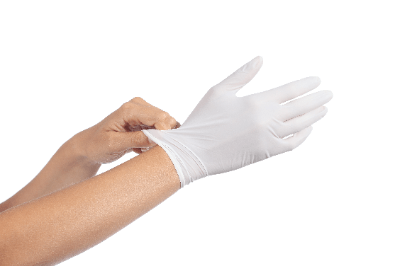What Is a Latex Glove?

A latex glove is a disposable glove used in laboratories and medical settings. Latex is a natural rubber extracted from rubber trees. Because they are made of rubber, they are soft, fit well on the hand, and provide a non-slip grip, making them suitable for detailed work. However, they have low resistance to oil and chemicals, so caution is needed. In some cases, nitrile gloves made of synthetic rubber are used to avoid allergic reactions in some individuals.
Uses of Latex Gloves
Latex gloves are commonly used in laboratories and medical settings. Due to their low resistance to oil and chemicals, they should be handled with care when dealing with chemicals. The primary concern when using latex gloves is the risk of allergies. Latex proteins in natural rubber can cause itching, hives, and other symptoms upon contact. Frequent use of latex gloves has been reported to increase the risk of allergic reactions, so caution is advised for laboratory and medical personnel.
Principles of Latex Gloves
Disposable gloves come in various types and grades, and selecting the appropriate one for the intended use is essential. Medical gloves, in particular, are subject to strict quality standards defined by JIS (Japanese Industrial Standards).
In addition to latex gloves, other commonly used disposable gloves include polyethylene gloves, PVC gloves, and nitrile gloves.
1. Polyethylene Gloves
These gloves are widely used due to their affordability and ease of use. Many of them comply with food safety regulations and are often used in food manufacturing. However, they do not fit well and are not suitable for detailed work.
2. PVC Gloves
PVC gloves, made of vinyl chloride, are resistant to chemicals and oil, making them suitable for various workplaces. They provide a good fit but are not recommended for use with food.
3. Nitrile Gloves
Nitrile gloves, made of synthetic rubber, offer a good fit similar to latex gloves but are chosen to prevent latex allergies. They have better resistance to oil and chemicals compared to latex gloves, although they are slightly more expensive.
Other Information on Latex Gloves
1. Latex Gloves for Medical Use
Medical personnel use gloves for various purposes, including surgery, examinations, medical checkups, and other tasks. Gloves used in surgery are subject to strict control and are regulated by the “Act on Quality, Efficacy and Safety Assurance, etc. of Pharmaceuticals and Medical Devices” (Pharmaceutical Machine Law).
These gloves are classified as Class 2 “controlled medical devices” and require certification by a third-party certification body for manufacture and sale. Gloves used for examination and medical checkups are treated as Class 1 “general medical devices,” and their manufacture and sale are subject to a notification system.
Ensuring the quality of medical gloves is crucial, and Japan has established five JIS standards for gloves manufactured in the country, depending on their intended use. Each type of glove has defined inspection standards for dimensions (width, length, thickness), pinhole testing, and physical properties (tensile strength, elongation).
- JIS T9107 “Disposable surgical rubber gloves“
- JIS T9113: Disposable dental rubber gloves”
- JIS T9114: Disposable dental vinyl gloves”
- JIS T9115 “Disposable rubber gloves for medical examinations and tests”
- JIS T9116 “Disposable vinyl gloves for examination and medical examination”
ASTM International is the world’s largest international standardization organization, and several ASTM standards are known for medical gloves:
- ASTM D3577, “Standard Specification for Rubber Surgical Gloves”
- ASTM D3578, “Standard Specification for Rubber Examination Gloves”
- ASTM D6319, “Standard Specification for Nitrile Examination Gloves for Medical Application”
- ASTM D5250 “Standard Specification for Poly(vinyl chloride) Gloves for Medical Application”
2. Powder-Free Latex Gloves
Some latex gloves are coated with powder on the inner surface to ease wearing. However, the U.S. Food and Drug Administration (FDA) has taken action to halt the distribution of powdered medical gloves due to safety concerns. Powdered gloves made of natural rubber are considered a potential risk factor as the powder can carry allergens, trigger allergies, or increase the risk of granuloma or postoperative adhesion formation.